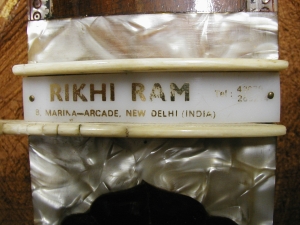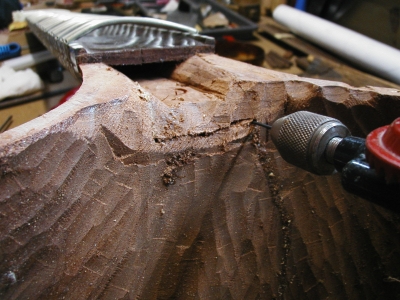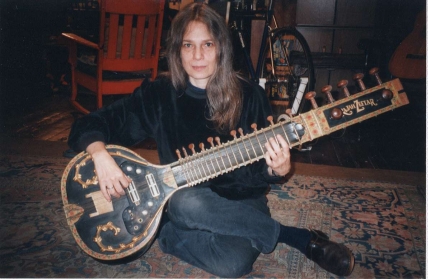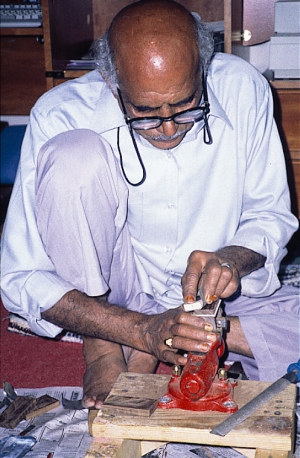meanwhile, just a taster…
Playing an electric sitar gives some weird possibilities.
Watch this Niladri Kumar on the electric highway.
The joint has been fitted and glued again. On the left hand side you can see some adjustment strips sitting between the joint and the body.
Then the tabli is glued to the body. A rope is used to keep the tabli fixed and under sufficient pressure at regular points along its contour.
Now this sitar body is ready to get some new polish. But unfortunately we have to wait for the good weather to come…
Here we go again …
Day 41 en 42: Making and glueing the parda lanes. These are long and thin strips located on the sides of the neck to hold the pardas.
… after some time the glue became softened and the joint can be removed.
Now, the wooden parts need some time to dry thoroughly.

This old Rikhi Ram is having a problem: the joint got loose.
I handled the same problem before on another (left – handed) RR sitar. On that occasion I made a new joint which took a lot of work to make it fit perfectly. Now I turned an old pressure cooker into a steam generator which is used for removing and loosening the animal glue.
First step is to open the sitar :
Then I drilled a fine hole in the corner area of the joint in which the needles will blast their steam.

I add water to the pressure cooker and have the power switched on …
Watch this video, made by my friend Denis on 29/05/1997 at my home in Bierbeek. At that time I’ve been inviting Hari Chand for the first time in Belgium and we temporarily turned the living room into a small improvised sitar workshop.
On this video Hariji is doing jiwari and I am watching carefully. Join us…
Read more about doing jiwari here…
A very special and most beautiful series of sitars and surbahars made by Dieter Zarnitz.
The tumba is replaced by a wooden construction as used in traditional western lute making. Neck and body are made from flamed maple, with old air-dried pine soundboard. The head and curl are made of rosewood, the tuning pegs are made from ebony.
Anyone ever seen this one in real ?

The Rajah Zeetar is an instrument made in the 1960’s in the likeness of a sitar. Supplied with an electronic amplifier. Made in Japan. It comes with 2 eye-catching big magnetic pickups and the body is made of papier-mache with a wooden soundboard, lenght is 112 cm.
Today I added a small article about “doing jiwari” to the maintenance page. This seems for so many an insurmountable task, for others it remains a sacred secret on which sometimes insiders make profit by doing or pretending that this is only to be touched by a lucky few.
Of course it is not an easy task to do, and surely it is not a good idea to experiment with your one and only finest staghorn jiwari immediately but look out for a piece of cheap camel bone, leftover ebony or fiber and make your own ghodi from scratch. It might take some time, but once you succeed to create a good sound with a self-made jiwari… a new world opens.
Doing jiwari is a question of practice. No written rules exists on how where and when to start filing or sanding. Just take your time to gently create a slow but steady, exponentially inclined curve. At regular times, create a finishing stroke with fine sandpaper and try out on your instrument. Remove it again and work further, step by step.
If you should ever see the jiwari which came first out of my hands 15 years ago, I think you will never alow me to even come close to your sitar… 😉
Feel free to read the article, and succes!!
